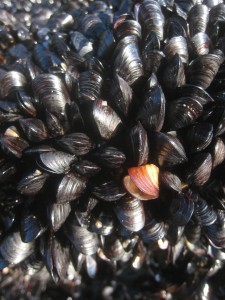
The nitrogen and phosphorus cycles in lakes are linked. Limits in phosphorus content help reduce algal blooms but make it harder for the lake to remove nitrate pollution naturally.
Science magazine recently reported on the linkage between nitrogen and phosphorus cycles in lakes.
Phosphorus pollution can lead to the buildup of algae in lakes and streams, making them unappealing for swimming and fishing. For this reason, phosphorus levels are actively managed to make freshwater bodies more attractive for recreational use. Reducing phosphorus levels has succeeded in reducing algae blooms, but also at least one unforeseen side-effect: it becomes more difficult to remove reactive nitrogen from those same bodies of water. This leaves water that appears cleaner, but is actually even more polluted with nitrogen.
The phosphorus and nitrogen cycles in lakes are linked. Although phosphorus content limits algae growth, the organisms consume at least 40 times more nitrogen. The algae convert reactive nitrogen (in the form of nitrates, or NO3) into inert nitrogen gas (N2), which can be released into the atmosphere or deposited in lake sediments. In this way, algal blooms function as nitrogen sinks removing nitrate pollution from the water. So as phosphorus levels in a lake increase, algae remove nitrogen more quickly. And if phosphorus supply declines, the algae population declines, and there is no mechanism to remove excess nitrates from the water.
In a recent Science paper, Finlay et al. analyzed the relationship between phosphorus content and nitrate removal in a sample of 101 lakes. The researchers compared the difference in the amount of nitrogen that enters a lake and the amount that is found in downstream rivers or creeks. This allowed them to determine how much nitrogen is removed from the lake. By correlating this data with the concentration of phosphorus over time, they were able to show that decreases in phosphorus are linked to slower rates of nitrogen removal. Further analysis revealed lakes with higher phosphorus levels not only removed nitrogen faster, but did so more efficiently. That is, a lake with a high phosphorus content removed a larger percentage of nitrate inputs than one with a low phosphorus content. This remains true even after compensating for the slower removal rate in the lake with low phosphorus content.
Futhermore, a closer look at only large lakes in the data set indicates that nitrogen levels have increased over time as their phosphorus concentrations have been actively managed. These data reveal that lake environments without the appropriate amount of phosphorus are unable to turn over reactive nitrogen species causing a build up of nitrates over time.
Nitrate pollution control is an increasing concern of environmentalists. Humans generate greater amounts of nitrogen waste each year from fossil fuel combustion, fertilizer usage, crop fixation and other activities. This waste is often buried in freshwater systems, imposing challenges on underwater plant and animal populations, as well as communities who rely on lakes for their drinking water. While phosphorus pollution is controlled to limit algal blooms, nitrate pollution has proliferated, creating these unforeseen challenges. At present, no scientific authorities advocate removal of phosphorus pollution controls as a solution to these problems. And the results of this study suggest a more holistic approach to phosphorus and nitrogen pollution instead of focusing on one variable at a time. As phosphorus pollution is already well managed, future solutions should focus on controlling nitrate pollution and maintaining the proper balance of nitrogen and phosphorus levels, to allow a lake to effectively clear pollution.
